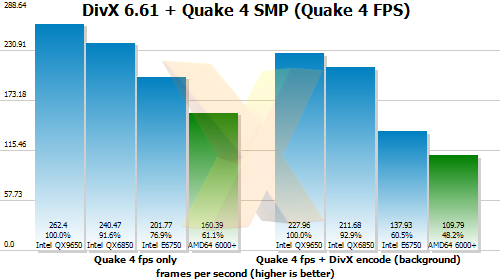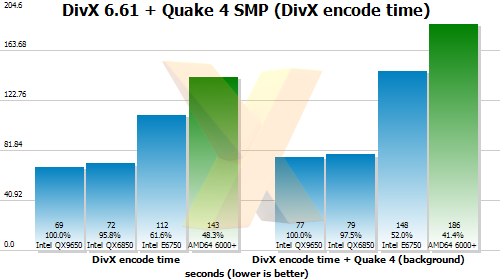Multi-tasking
Single benchmarks often make it difficult to see the benefit of multi-core processors, since they leave two or three cores sitting around idle.
However, the reality is that few people using PCs only carry out one task at a time - they have lots of apps on the go and that's when the true benefit of multi-core processors can be seen.
For our first test we run our DivX encoding benchmark while playing back a 1080p QuickTime-encoded video.
We record the total times taken to compete the DivX encode and compare them with the original DivX-only results. Naturally, we also take a look at the QuickTime playback, to see if we can spot any dropped frames during playback.
After that, we run the DivX encoding test at the same time as our Quake 4 game test. This allows us to see how a heavy, multi-threaded, load affects the performance of the DivX encoding and the impact on the performance of Quake 4.

The left-hand graphs represent standalone DivX performance, as shown on page six. Concurrently running a 1080p QuickTime clip adds seven seconds to the encode process on both quad-core processors. Note, though, how the dual-core processors struggle, comparatively speaking, with the additional load of the QuickTime clip. We noted that the Athlon 64 X2 6000+'s could barely muster 1fps when rendering the clip - representing another foible in the system setup. The Intel Core 2 Duo E6750 would intermittently drop frames. Both quad-core processors provided a perfectly smooth playback.

When running the same DivX-encoding test with Quake 4 executing in the background, we see that, again, both quad-core processors lose little with respect to Quake 4 frame rate, although the QX9650 system did crash a couple of times. Dual-core performance isn't stellar, with both Intel and AMD's processors taking a frame-rate beating and making the game feel a little choppy.

Looking at the DivX encoding times with our Quake 4 demo running, we see that, once again, the performance decrease on the quad-cores is considerably less than that on the dual-core CPUs. The Penryn enhancements take a back-seat to the power of four execution cores.









